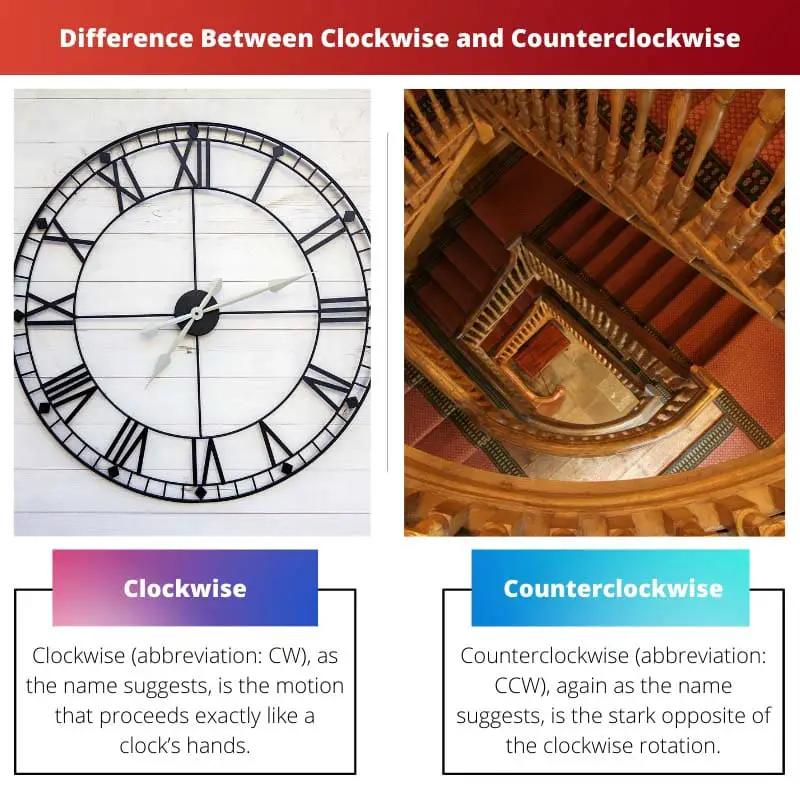The English vocabulary is rich with verbs, adverbs, adjectives and nouns to give meaning to every bit surrounding us.
To understand the movement of a certain something in a given period, we use adverbs/adjectives such as clockwise and counterclockwise. These adverbs describe the motion of an object in the right or left direction.
The movement occurs in a circular format, i.e. it’s either towards the right to the top and the left to the bottom of the circle or vice versa for clockwise.
For counterclockwise rotation (also known as anti-clockwise), the direction is in the stark opposite direction of the clockwise rotation.
If used as adjectives, clockwise would mean moving in a rotating motion like any clock does, while counterclockwise would be moving in a direction exactly opposite to the clockwise direction.
Key Takeaways
- Clockwise refers to the rotational direction of a circle’s movement that follows a clock’s hands.
- Counterclockwise describes the opposite direction, moving against the path of a clock’s hands.
- The terms describe the orientation of screws, bolts, or rotational movements in various applications.
Clockwise vs Counterclockwise
The difference between Clockwise and Counterclockwise is that in a clockwise circular motion, the movement follows the movement of any clock, i.e. right to left. In contrast, in a counterclockwise motion, as the name suggests, the movement counters the clockwise movement and moves from right to left instead.

Clockwise (abbreviation: CW), as the name suggests, is the motion that proceeds precisely like a clock’s hands.
The movement begins from the top, goes around towards the right, proceeds to the bottom, moves upwards to the left, and then back again to the top position from where it started.
Counterclockwise (abbreviation: CCW) is the stark opposite of the clockwise rotation. Here, the movement starts from the top, heads towards the left, goes down, proceeds towards the right side, and ends up at the top from where it started.
The nature and pace of the movement remain the same; only the direction changes. The rotation is also known as anticlockwise (ACW).
Comparison Table
| Parameter of Comparison | Clockwise | Counterclockwise |
|---|---|---|
| Abbreviation | CW | CCW |
| Definition | Clockwise (abbreviation: CW), as the name suggests, is the motion that proceeds precisely like a clock’s hands. | Counterclockwise (abbreviation: CCW) is the stark opposite of the clockwise rotation. |
| Movement | From left to right. | From right to left. |
| Examples of CW movement | Unlike other planets, Venus and Uranus are the only two planets which revolve around the sun in a clockwise direction. | Earth and other planets, except for Venus and Uranus, revolve around the sun in a counterclockwise direction. Earth also rotates on its axis in a counterclockwise direction. |
| Synonyms | None. | Anticlockwise. |
What is Clockwise?
Clockwise (abbreviation: CW), as the name suggests, is the motion that proceeds precisely like a clock’s hands.
If we are to describe any motion or movement which is circular, like the rotation and revolution of planets or the direction of the wind or the simple movement of a windmill or tyres of a car forming or waves in an ocean,
we understand the direction of these motions, i.e. from left to right and call it clockwise motion.
The movement begins from the top, goes towards the right, then to the bottom, then moves upwards to the left, and then back again to the top position from where it started.
The naming of motions is very handy in Physics. Many laws and theories are formulated based on “clockwise” motion.
You should know that, unlike other planets in the solar system, Venus and Uranus are the only planets that revolve around the sun in a clockwise direction. All the other planets revolve counterclockwise.

What is Counterclockwise?
Counterclockwise (abbreviation: CCW), again, as the name suggests, is the stark opposite of the clockwise rotation. As mentioned earlier, if we are to describe any motion or movement which is circular,
like the rotation and revolution of planets, or simple movement of a windmill or tyres of a car or the direction of the wind, or forming of waves in an ocean,
we determine the direction of these motions, i.e. from right to left and call it counterclockwise or anticlockwise motion.
The movement starts from the top, goes around towards the left, then to the bottom, then moves upwards to the right, and then back to the top position from where it started.
You see, the exact opposite but at the same pace! The nature and pace of the movement remain the same; only the direction changes. The rotation is also known as anticlockwise (ACW).
You should know that all planets in the solar system except for Venus and Uranus planets revolve around the sun in a counterclockwise direction. Also, Earth rotates on its axis in the counterclockwise/anticlockwise direction.

Main Differences Between Clockwise and Counterclockwise
- The abbreviation for Clockwise is CW, and the abbreviation for Counterclockwise is CCW.
- Clockwise (abbreviation: CW), as the name suggests, is the motion that proceeds precisely like a clock’s hands. Counterclockwise (abbreviation: CCW) is the stark opposite of the clockwise rotation.
- The clockwise direction is from left to right. Whereas, Counterclockwise direction is from right to left.
- Unlike other planets, Venus and Uranus are the only two planets which revolve around the sun in a clockwise direction. All other planets follow a counterclockwise direction. Also, Earth’s rotation about its axis is anticlockwise.
- ‘Clockwise’ has no synonyms, whereas ‘Counterclockwise’ is called ‘anticlockwise’.

- https://www.pnas.org/content/107/29/12846.short
- https://www.ingentaconnect.com/content/asma/asem/2003/00000074/00000006/art00001

The comparison table and the in-depth analysis of the terms are exceptional. A well-structured and high-quality article on the topic!
For sure, Oscar. I was impressed by the writer’s knowledge and writing skills.
I have to say that the compelling and thorough explanation of CW and CCW movements is really appreciated. Fantastic job!
Totally, Saunders. It’s been a great learning experience reading this post.
I was never clear on this until I read the article. Now everything makes sense!
I’m fascinated by the detail and depth of information in this post. It’s educational and engaging.
Couldn’t agree more, Harry. It’s one of the best explanations I’ve read on this topic.
This is an excellent article. The explanation is clear and easy to understand. It makes sense now.
The comparison table makes it very easy to grasp the concepts of clockwise and counterclockwise.
Wow! It’s amazing to see such a detailed explanation and useful examples to understand the differences; really great job!
Absolutely, the explanation was really thorough and clear. I had no doubts after reading this article.
This information is very educational. It is helpful for anyone who wants to understand these concepts better.
Totally agree, the examples for both CW and CCW directions are really helpful.
I’ve learned so much about CW and CCW movements from this article. The writer should be commended for their effort!
Absolutely, Chloe. It’s hard to find such well-written and descriptive articles on these topics.
I have never seen such a complete explanation of the concepts of clockwise and counterclockwise. It’s fascinating!
I think this article is very valuable for those interested in better understanding rotational movements.
There is no doubt how beautiful our language is, allowing us to describe the most complex concepts. The explanation about the difference between clockwise and counterclockwise is unique and easy to understand.
I’m really impressed with the detailed analysis and the use of synonyms and antonyms to highlight the difference.
My thoughts exactly, Davies. A great explanation for those who want to understand clockwise and counterclockwise movements!
Super interesting and easy to follow. The clear and concise language makes this quite accessible for everyone.
Absolutely, Tara. The information about the planets and the Sun was something I didn’t know.
I agree, and the brief history of CW and CCW movements is insightful too.